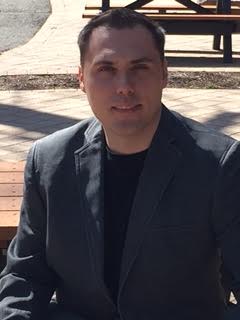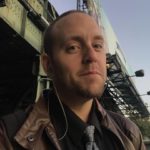
 Review Fix chats with author Max Orsini, who discusses the inspiration and importance of his new book, “The Buddhist Beat Poetics of Diane di Prima and Lenore Kandel.â€
Review Fix chats with author Max Orsini, who discusses the inspiration and importance of his new book, “The Buddhist Beat Poetics of Diane di Prima and Lenore Kandel.â€
For More on the Book, Click Here.
About the Author:
Max Orsini is a poet, critical-essayist, teacher, and singer-songwriter from Brooklyn, New York. Max received a BA in English, Creative Writing and Gender Studies from Washington College (2003), and MA in English from Drew University (2005), and, most recently, a Doctorate in Arts and Letters from Drew University (2016)—in addition to completing PhD coursework in English at The University of Rhode Island (2009.) For his literary dissertation, he received both the mark of academic distinction and the Robert L. Chapman award for creative thought and excellence in prose style from the Caspersen School of Graduate Studies. In 2018, Max’s dissertation, The Buddhist Beats Poetics of Diane di Prima and Lenore Kandel will be published by the authority on Beat Generation Studies—Beatdom Press. Max teaches courses in Writing/Composition, Literature, Culture, and Vocational Life at Drew University, Fairleigh Dickinson University, and Montclair State University.  This year, he will be working as Graduate Writing Specialist in Drew’s university writing center. Max currently lives in Madison, NJ, but he has also lived in Maryland, New England, Italy and also Switzerland—where he completed his high school education “among the trees and mountains of sublime and sacred landscape.â€
Review Fix: What inspired the book?
Max Orsini: In a broader sense, what inspired the project was my interest in, and commitment to, poetry as a craft, and as a vital American art form. I have been studying poetry closely for almost twenty years now, and this text is, in many ways, the culmination of two decades of thinking about what poetry means and does for us—spiritually, socially, communicatively, silently and even as an intimate form of survival (or an agent in the survival of human intimacy and proximity).  In a more local or particular sense, the text is emblematic of a confluence of three burgeoning interests that sprung up with full force in my thirties: Beat poetry and sixties aesthetic and cultural life, Buddhism and Eastern religiosities, and the generative vivacity of U.S. women’s literature as a body of still under-examined text(s). In some ways, I stumbled upon Beat literature—partly because it’s been traditionally deemed “non-canonical†(and thus virtually absent from my formative literary education), and partly because, well, I had my eyes on other writers and texts and my ears pinned close to the cellar doors of other voices.
Review Fix: What was the research process like?
Orsini: The research process was marked by immense urgency, and a wave of energetic, kinetic intent. This is because I wrote the manuscript that has become this book as my Doctoral Dissertation. But while I was feverishly writing the text with graduation on my mind in 2015-16, I always held the notion somewhere in the middle of my mind that I wasn’t just researching for a dissertation, but rather for a book, or a couple of books, even. So the research process was mostly quite exciting, save for a couple of moments when I needed what I call “textual bridges†over scholarly “troubled waters.†Under the tutelage of a couple of prudent and generous mentors, I found my way through the mire of interdisciplinary research—a mire that can quickly become writerly quicksand if one is not keenly aware of what one is doing, drawing as a project like this does on various philosophies, fields and methodologies in order to make a comprehensive claim about religion’s capacity to influence literature, and art.
Review Fix: What was the hardest part of writing this book?
Orsini: Initially, simply narrowing the scope—and accepting the fact that was not after all going to be a mega-discourse on various spirito-literary movements in American women’s literary history. I had initially sought to trace a kind of dharma impulse pervading 20th-century American women’s literary schools or movements but ultimately recognized that the nucleus of my true attention lay in Beat poetry and Beat scholarship. Beyond that, I would say that finding what I call the “keystone†texts in the research project initially presented the greatest difficulty. For instance, once I discovered the American Buddhist cult classic, Zen Mind Beginner’s Mind, by Shunryu Suzuki, and then later realized that my poets had studied Zen with him, and also quoted and drawn on him for inspiration, I saw that Japanese, Zen frequencies were indeed pulsing in the brains, spirits, and hands of my Buddhapoetic authors. Connecting history, biography and literature, therefore, allowed me to capture the mystifying unity that initially eluded me at the inception of the project. In essence, what I surmised was that biography and literature, together, were not enough. I needed cultural history to become the glue in between—and I’m hoping I have made that audible in the pages of the book.
Review Fix: Why is this subject matter important today?
Orsini: I speak about this, to some minor extent, within the book itself, pointing to the ways poetry and spirituality can help heal our collectively war-shaken lives, our collective human consciousness. The Beats were very, very mindful of the effects of war on the human spirit, and certainly, we must absorb the energy of their compassionate concerns and continue to transfer these energies in our perpetually tumultuous and alienating political lives so as not to be “beat†or psycho-spiritually exhausted beyond hope and repair.
From a scholarly perspective, a relatively small portion of attention has been paid to women of the Beat Generation (though that has been gradually changing over the past two decades or so). And this naturally relates to the burgeoning attention we in the twenty-first century are at last beginning to pay women in general. In an age where many people have grown tired of ostensibly fabricated gender dualism, this work helps to highlight that women writers—and women at large—are making inordinate creative and social contributions worth enduring regard.
Spiritually, I think this book adds to the increasing religious pluralism and creative spiritually taking shape in various sectors of contemporary America. I think reading this book might allow one to consider spiritual paths “hidden in plain sight,†to quote David Foster Wallace. In a nation where yoga, meditation, zazen, and mindfulness have become nearly as commonplace as Pop Music, SUVs, Starbucks or Twitter, learning about the original flourish of Eastern spirituality in the United States can help one gain a deeper sense of one’s nuanced historical identity and a broader framework for religious history and cross-cultural hybridizations at large. And this, in turn, allows us to recognize that we are all in a sense migrants, that we are all on the move, all seeking our own lyric enlightenments throughout the course of our shared human journeys.
I also believe that a book like this can offer people a window toward appreciating poetry in a way that they might not have before. The poets I discuss in this book utilized lyric poetry as a means to discover an ever-evolving and marvelously vulnerable selfhood. There is nothing more American than the concept of selfhood (as far as I can tell at least). As the writer Charles Johnson has suggested, “self†is really more a verb, than a noun. It’s a word indicative of a process, the Whitmanesque sense of ever “moving toward,†ever “speeding†on. In America, we spend a lot of time measuring tangible accelerations, be they in cars, stocks, accounts, scholastic degrees, and occupations. The poets in my book explore spiritual velocities and take the temperature of suffering with their mercurial yet mindful poems.
Review Fix: What have you learned about yourself through this book?
Orsini: I have learned a few very important things. The first is that art remains a definitive path to the spiritual (and, of course, we say a phrase like “path to the spiritual†with a healthy amount of linguistic trepidation). I have also learned that writing a book is a uniquely transformative act, a mutative process, a synthetic endeavor that allows one to sort of merge the waters of one’s experience in a kind of collective channel of thought and feeling. I have also learned that I would like to write more, meditate more, research more, create more, and reflect further upon the ways that literature has been the mirror to psyche, spirit, environment, and historical imagination.
 Review Fix: How do you want it to affect people?
Review Fix: How do you want it to affect people?
Orsini: A writer who plans to review this text told me recently that he felt that the book was very “readable.†That simple comment meant a great deal to me, because if my work is not readable, if it is not accessible to people, it limits the chances for communion between writer and reader. I want the reader of my book to experience a kind of communion, a kind of interdependent feeling—a recognition that it’s still pretty wonderful to be alive together as human beings in the mosaic of the world. Above all, I want them to use some chapter, or paragraph, or sentence, or phrase of my work to commune again with themselves.
There are lots of different kinds of reading and viewing and listening that are totally valid and valuable in our world today, but few of them express the ineffable in the same ways that poetry or good short stories can. Diane di Prima and Lenore Kandel expressed the ineffable in marvelously minute and cosmic ways.
I therefore want readers to ultimately recognize the great achievements of these two great poetic composers—di Prima and Kandel.
Review Fix: What are your goals for the book?
Orsini: I hope to present some talks on the text, sell a fair number of copies, and use the text to make my own scholarly contribution to the fields of Beat Studies, American Buddhism, or Women’s Studies.
Review Fix: What’s next?
Orsini: I am considering a few different projects. One concerns the work of Herman Hesse (potentially in tandem with one of his translators, the American poet, James Wright). I am also thinking of a book on American/Western short story and the various shifting meanings of “home†in between the two world wars. Finally, I’d like to get back to my own creative writing, and produce some more poems, if muses oblige.
Review Fix: Anything else you’d like to add?
Orsini: Just that I’m grateful for the opportunity to share my book and my insights here on your interesting pop cultural site. If anyone should wish to contact me for a reading, lecture, or just to talk about the text, I can be reached at [email protected]. Thank you.


Leave a Reply